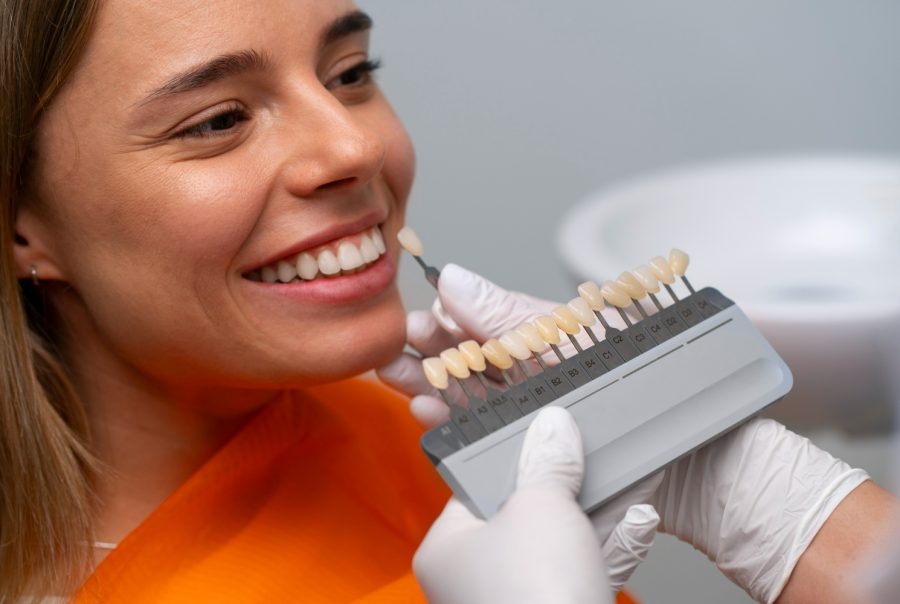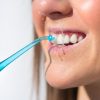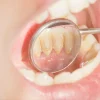Get information about Zirconium crown treatment with the explanation of specialist dentist Merve Özkan Akagündüz.
Zirconium Dental Crown

Zirconium Dental Crown, Doredent İstanbul
Today, focusing on dental aesthetics and health, many innovative methods are being developed. One of these is zirconium dental crowns, a ceramic material used in dentistry. Zirconium dental crowns are a treatment option that provides the closest aesthetics and durability to natural teeth. These crowns are primarily made of a white metal called zirconium dioxide (ZrO2), commonly used in dental crowns, implant abutments, bridges, and other prosthetic applications, ensuring excellent harmony with the tooth color.
Zirconium dental prostheses are preferred for providing an aesthetic similar to the natural tooth color and tissue structure. Additionally, zirconium’s durability and biocompatibility have made it popular in dental applications.
Advantages of Zirconium Dental Crowns:
- Aesthetic Appearance: Zirconium dental crowns mimic the appearance of natural teeth perfectly, providing superior aesthetics in terms of color, shape, and naturalness.
- Durability: Zirconium is a highly durable material. Due to its high strength, these crowns are long-lasting and resistant to daily use.
- Biocompatibility: Zirconium is compatible with the body and does not cause allergies or other reactions.
- Thin Structure: Zirconium dental crowns have a thin structure, requiring minimal intervention on the teeth. This preserves the natural appearance while maintaining healthy tooth structure.
- Color Stability: Zirconium crowns do not change color over time and are resistant to staining from substances like tea or coffee.
- Easy Maintenance: Zirconium dental crowns require regular dental care, similar to natural teeth. Brushing teeth, using dental floss, and regular dental check-ups are recommended.
The use of zirconium in dentistry has become more widespread with technological advancements. The history of zirconium dental prostheses has progressed parallel to developments in the ceramic industry. Zirconium’s popularity in dental applications has increased, especially since the early 2000s.
Zirconium’s durability, aesthetic appearance, biocompatibility, and longevity have contributed to its popularity in dental practices. Furthermore, advancements in computer-aided design (CAD) and computer-aided manufacturing (CAM) technologies have enabled the production of zirconium dental prostheses with greater precision and accuracy.
What Role Does Zirconium Play in Digital Smile Design?
Digital Smile Design (DSD) is a process that helps dentists create more beautiful and natural smiles for patients using digital technology to enhance dental aesthetics. DSD is an interactive process between the patient and the dentist, using digital tools to plan aesthetic dental designs based on the patient’s desires, expectations, and physical characteristics.
Zirconium can play a significant role in the DSD process. Its close resemblance to natural teeth makes it a frequently preferred material for restorations used in DSD. These crowns perfectly mimic the natural tooth structure and can achieve remarkable results in aesthetic smile design.
During the DSD process, the dentist evaluates the patient’s facial structure, lip line, smile line, and other critical aspects. Based on these assessments, zirconium dental crowns can be designed to achieve the desired aesthetic outcome for the patient. Additionally, since dental design is planned digitally in DSD, zirconium dental crowns can be manufactured directly based on digital design data, allowing for more precise and accurate results.
In conclusion, zirconium is a reliable and popular material for creating natural and aesthetic smiles in the Digital Smile Design process. Integrated with digital technology, it helps achieve natural and attractive smiles that meet patients’ desires. Zirconium dental crowns offer long-term solutions due to their durability and aesthetic appearance. However, since every patient is unique, the treatment process and stages may vary based on the patient’s specific needs. Therefore, consulting a dentist is essential to determine the most suitable option for zirconium crowns or any other dental treatment. It should be noted that positive outcomes are achieved when patients, dentists, and technicians collaborate ideally, and the treatment is applied accordingly.
How Are Zirconium Crowns Made? What Are the Treatment Stages?
The fabrication of zirconium crowns is typically completed in several stages:
- Examination and Planning: Initially, the dentist examines the patient and evaluates their suitability for zirconium crown application. Then, based on the condition of the teeth and the patient’s preferences, a treatment plan is formulated. Factors such as the patient’s smile, tooth color, and shape are thoroughly examined.
- Tooth Preparation: Before applying the zirconium crown, the dentist shapes the natural tooth by removing a thin layer. This ensures proper fitting of the crown. Tooth preparation is done under local anesthesia, and the dentist takes necessary measures to ensure the patient feels no pain or discomfort.
- Impression Taking: The dentist takes an impression of the prepared tooth. This impression is sent to a laboratory where the zirconium crown is custom-made to fit perfectly on the natural tooth. If possible, digital impression recording, computer-aided design (CAD), and computer-aided manufacturing (CAM) reduce margin of error and facilitate achieving a healthy final restoration.
- Temporary Crown (Optional): The production process of zirconium crowns may take several days. During this time, a temporary crown can be applied to protect the patient. This temporary crown preserves the natural tooth aesthetically and functionally. Depending on suitability, the dentist may place a temporary crown shortly after the preparation stage.
- Application of Zirconium Crown: When the zirconium crown arrives from the laboratory, the dentist verifies it and carefully places it. The crown is positioned to ensure proper fit and harmony with the patient’s oral structure.
- Adjustment and Final Check: After placing the crown, the dentist makes any necessary adjustments and checks the patient’s bite level. Additionally, a final aesthetic evaluation is conducted to ensure patient satisfaction. Zirconium dental crown applications require close collaboration between dentists and technicians. This ensures that patients achieve a natural and aesthetic smile. Furthermore, zirconium crowns offer long-term solutions due to their durability and aesthetic appearance. However, since every patient is unique, the treatment process and stages may vary based on the patient’s specific needs. Therefore, consulting a dentist is essential to determine the most suitable option for zirconium crowns or any other dental treatment. It should be noted that positive outcomes are achieved when patients, dentists, and technicians collaborate ideally, and the treatment is applied accordingly.
Frequently Asked Questions
What is zirconium and what are its areas of use in dentistry?
Zirconium is essentially an element. In dentistry, it is commonly used as the substructure (supporting structure) material for coatings in prosthetic treatments, and sometimes even to make the coating itself.
What are the advantages of zirconium crown? Why is it preferred?
Before zirconium began to be used in dentistry, metal-based porcelain was generally used. Since the metals used in the substructure are gray in color and should be masked with a matte concealer to prevent their color from reflecting outward. Zirconium substructures, on the other hand, have a translucent property and are white in color, which allows them to have a brighter and more aesthetic appearance, far from this matte appearance.
In which cases are zirconium crown preferred more in dental literature?
- When aesthetics and appearance are crucial, prosthetic coverage of the anterior teeth may be necessary:
- In cases of anterior dental spacing
- For the treatment of fractures resulting from trauma to the teeth
- To address excessive discoloration of the teeth
- As a dental prosthesis to be placed over implants
How is a zirconium tooth applied to the patient?
First, a certain amount of material is removed from all surfaces of the tooth to bring it to the required size. After the necessary preparation, the tooth is slightly reduced from its original size. Then, the new situation is recorded with a measurement, and laboratory work begins. After the necessary fittings and evaluations are made to meet the patient’s expectations, zirconium crowns are finalized and the treatment is completed by cementing (bonding) them onto the teeth.
What is the duration of the production process of zirconium dental crowns? How many sessions does it take?
Depending on the number of teeth to be treated, it takes approximately six to eight days. If a small number of teeth are treated, it can be completed in two sessions, but generally, it is done in three sessions.
After the teeth are prepared for veneers, do they remain in a smaller size until they are placed?
After the teeth are prepared in the session and the measurements are taken, temporary teeth, which we call provisional prostheses, are cemented (attached). This way, there are no aesthetic issues encountered.
Is the process of making prosthetic teeth (crowns) painful?
During the treatment process, there are no significant pains. Since the abrasion is performed under local anesthesia during the session, there is no serious sensitivity during the procedure. The temporary teeth applied after the procedure also protect our patients from sensations such as pain or tingling during the production process of zirconium teeth.
What is the lifespan of zirconium crowns?
The answer to this question depends on the individual’s maintenance, but they can last for long periods such as 12 to 15 years.
How durable is zirconium tooth?
Zirconium crowns can easily withstand all the forces that natural teeth can endure. You can comfortably consume all kinds of food without any worry.
How should the maintenance of zirconium crowns be performed?
There is hardly any difference from natural teeth. It is sufficient to brush them with a toothbrush twice a day regularly and to prevent the accumulation of food residues around them with dental floss.
Do zirconium dental crowns stain?
They can stain to a lesser extent than natural teeth, but exposure to highly pigmented foods or agents such as tea, coffee, or cigarettes can cause discoloration. Therefore, it is recommended to avoid excessive consumption of such foods.
Merve Özkan Akagündüz
I was born in Edirne in 1988. In 2007, I began my master’s degree in Dentistry at Istanbul University (Çapa) Faculty of Dentistry and graduated in 2012.
In 2014, I started my specialization in the Department of Orthodontics at Süleyman Demirel University Faculty of Dentistry. In 2019, I earned the title of Orthodontist and was appointed to Çorlu ADSM, where I worked as an Orthodontic Specialist Dentist from 2019 to 2022.
As of 2024, I have been continuing my practice in my own clinic.








